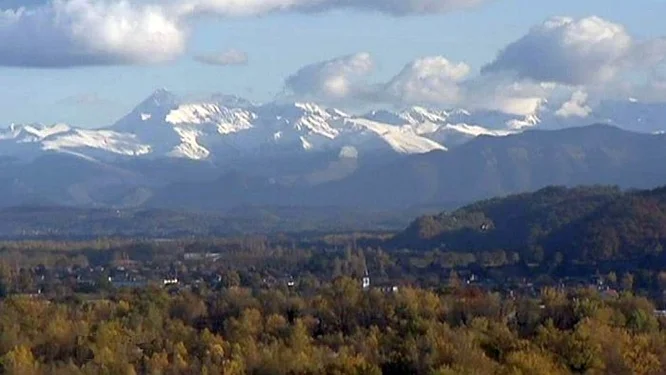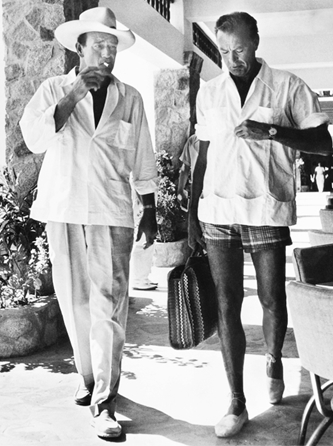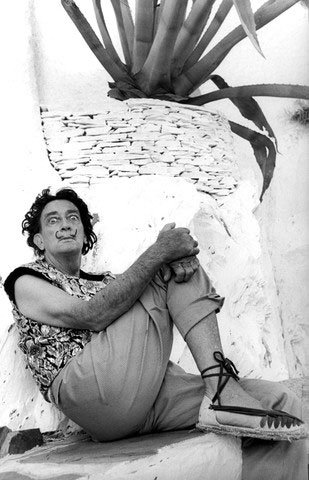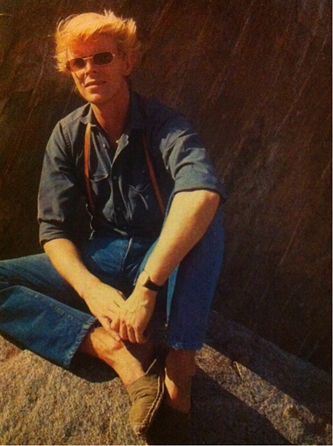Today, the Tour de France travels from the elegant valley town of Pau to the mountain town of Peyragudes in the rugged High Pyrenees. At its most brutal, this tour travels from an altitude of 1640 feet to that of 5758 feet within a distance of 24 miles.
From top: Pau, the beginning of today's stage in the Tour de France, with the Pyrenees in the background. Peyragudes, the finish of today's stage in the Pyrenees.
I can relate to some extent as I crossed that area by bicycle in 1982, though not that exact route. My ex-husband and I were doing a 5-month, 5-country bicycle tour of Europe on a shoestring budget, camping out and cooking on our little camp stove. We traveled along the southern coast of France from the Camargue region, famous for its cowboys, to the peaceful seaside town of Banyuls, the second to last town before the Spanish border.
From top: The Mediterranean port of Banyuls. A fisherman attending to his nets. A petanque (boules/bocci) field in Banyuls. Photos Travellati Tours.
Last month, when I saw several bike tourists with their map spread out in front of them at the Grand Café in the Pyrenees town of Céret, I introduced myself and told them I had once ridden into Céret myself on a bike. They then asked me for advice on the route to take for the day, so I suggested a scenic route to the medieval town of Carcassonne. This town is mentioned in Ernest Hemingway’s The Garden of Eden, in which the characters go for a bike ride to Carcassonne.
From top: Bike tourists at the Grand Cafe in Céret. Their map. Photos Travellati Tours. The medieval town of Carcassonne.
We spent a couple of weeks in Banyuls back in ‘82, taking a vacation from our vacation, swimming in the bay, visiting the sea creatures in the aquarium, and generally taking it easy. And we even ate out once – I remember a lovely plate of fritures, little tiny fried fish, eaten at a restaurant on the sweeping, curved bayside walk. Last month, I dined again at perhaps the same restaurant on Catalonian tapas, served by a sweet waiter who kept calling me “gente dame,” meaning something like “gentle lady.”
From top: Lunch along the beach in Banyuls. Tapas including fresh locally caught anchovies. Photos Travellati Tours. "Bols de Picolat."
Another day we were having a leisurely breakfast in a workingman’s café with little cubbyholes in the wall where each regular patron kept his cloth napkin. As we were reading, a piquant and savory aroma emerged from the kitchen, so we decided to stay for lunch. It turned out to be “Bols de Picolat,” a Catalonian meatball dish with a tomato sauce containing green olives and peppers. Last month, I had the good fortune to relive this moment when I was in the tiny Pyrenees town of Saint-Laurent-de-Cerdans and had lunch at the local café. The owner offered me the special of the day: “Bols de Picolat” and I was overjoyed.
From top: View of Saint-Laurent-de-Cerdans. Murals at Saint-Laurent-de-Cerdans showing the dancing of the Sardane (center). Photo Travellati Tours. People dancing the Sardane in Céret wearing espadrilles.
I was just in Saint-Laurent-de-Cerdans to visit the last remaining espadrille factory in the Pyrenees, as well as the canvas factory right next door that provides the fabric for the espadrilles. We had a tour of both before, of course, buying a few souvenirs.
From top: The warp being spooled, espadrilles, chairs covered in the same canvas. Photo Travellati Tours.
Espadrilles are the traditional shoes of the Catalonian region (though the Basques at the other end of the Pyrenees have something similar). They’re made with a braided rope sole that conforms to the sole of your foot, and the uppers are made with tightly woven canvas of various colors. The traditional form is the Vigatane Catalane, named after the town of Vic where they originated. These are traditionally black with an elegant shape and laced up by long black ribbons. These are worn by both men and women and there is no right or left foot. After trekking through Paris for two weeks, walking up to 5 miles a day, my feet were quite beat up. The guide in town said that she hasn’t had back pain since she started wearing espadrilles when giving tours. I bought a couple of pairs and had no more blisters or sore feet. Yay!
Clockwise from top left: Gary Cooper, Salvador Dali, David Bowie, and John F. Kennedy wearing espadrilles.
The 200 color-ways of the brightly striped canvases are named after various towns in the region, reflecting the colors of each particular area. Although only 38 colors of thread are used to weave the fabric, an infinite number of colors can be created by combining various colors of threads to create a new color, much as the Impressionist dabs of various shades blend when seen from far away.
From top: The 38 colors of threads used to make all the colorways; a draft of a new pattern inspired by watermelons showing how additional shades are created by blending different colors of thread together; three of the original patterns from this factory. Photos Travellati Tours.
For art lovers, there has never been a better opportunity to visit the Eastern Pyrenees.
A yarn-bombed olive tree outside the Modern Art Museum of Céret. Photo Travellati Tours.
And please take a moment to introduce us to friends or family members who would love our tours. They will thank you, and we will thank you with a generous referral bonus.


























